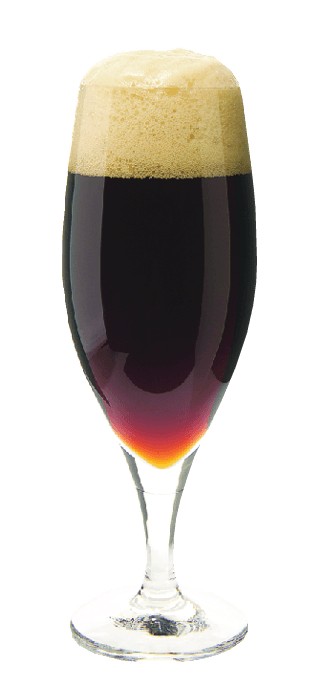1744 Porter
1744 Porter
(5 gallons/19 L, all-grain)
OG = 1.080 FG = 1.020
SRM = 57 IBU = 46 ABV = 7.9%
Since the hops were only used for bittering in the original, I opted for a high alpha-acid US hop, Columbus, and upped the IBU level a little just to give a round number for the weight of hops used.
Ingredients
12.25 lb. (5.6 kg) 2-row pale malt
2 lb. (0.91 kg) amber malt
2 lb. (0.91 kg) brown malt
0.8 lb. (0.36 kg) black malt
12 AAU Columbus hops (90 mins) (1 oz./28 g at 12.4% alpha acid)
Wyeast 1098 (British Ale) yeast (2 pkts in a 1 qt./1 L starter)
Priming sugar (if bottling)
Step by Step
Mash grains at 152–154 °F (67–68 °C) for 60 to 90 minutes. Sparge one hour, with water no hotter than 175 °F (79 °C) to collect about 6 gallons (23 L). Boil for 90 minutes, with bittering hops added at start. Cool as quickly as possible to 70–75 °F (21–24 °C). Pitch with yeast as a 1 qt. (1 L) starter prepared previously and allow to ferment for five to seven days. Rack to secondary for one to two weeks, then prime with sugar and bottle, or keg in the usual manner.
* Note that one thing I did not mention in the story was the yeast. We know nothing about the yeast used in Ellis’ recipe, but Samuel Whitbread was brewing porter in 1744, so a Whitbread yeast strain is about as authentic as it is possible for us to get.
1744 Porter
(5 gallons/19 L, partial mash)
OG = 1.080 FG = 1.020
SRM = 57 IBU = 46 ABV = 7.9%
We must use brown malt in this so we shall have to do a partial mash along with the extract. You could use 6 lbs. (2.7 kg) light liquid malt extract (LME) in place of 9.25 lbs. (4.2 kg) pale malt, and do a partial mash with 3 lbs. (1.4 kg) pale malt and the amber, brown and black malts. But that means a partial mash of just less than 8 lbs. (3.6 kg) in weight, which I think most homebrewers would find a little too much to handle. I have therefore developed a more suitable recipe, based on an amber malt extract (preferably one made with crystal malt and Munich malt), eliminating the use of amber malt and reducing the amount of brown and black malts.
Ingredients
9.5 lb. (4.3 kg) amber liquid maltextract
1 lb. (0.45 kg) 2-row pale malt
1 lb. (0.45 kg) brown malt
0.5 lb. (0.23 kg) black malt
12 AAU Columbus hops (90 mins)(1 oz./28 g at 12.4% alpha acid)
Wyeast 1098 (British Ale) yeast (2 pkts in a 1 qt./1 L starter)
Priming sugar (if bottling)
Step by Step
Place the crushed grains in a muslin bag, add to 2 gallons (7.6 L) of water at 165 °F (74 °C), and keep at 150–155 °F (66–68 °C) for 30 to 60 minutes. Remove the bag, rinse with hot water two or three times, collecting the runnings in the brew pot. Do not squeeze the bag (see tips for success, below). Add the malt extract, stirring well to ensure it is properly dissolved, then bring to a boil and continue heat for 90 minutes, with bittering hops added at start. Cool as quickly as possible to 70–75 °F (21–24 °C). Pitch with yeast as a 1 qt. (1 L) starter prepared previously and allow to ferment for five to seven days. Rack to secondary for one to two weeks, then prime with sugar and bottle, or keg in the usual manner. If priming, refer to BYO’s priming chart at https://byo.com/resources/
carbonation for guidance.
Tips for Success:
For partial mash brewers, resist squeezing the grain bag. Brew Your Own’s Mr. Wizard, Ashton Lewis, explains that when specialty malts are steeped in a grain bag the grains really do not behave as a filter and trub is not filtered from the wort, as is the case when a mash tun or lauter tun is used to separate spent grains from wort. Nonetheless, some of the trub is retained in the grain bag. By squeezing the grain bag more trub and cloudy wort is moved into the wort. This is why gently rinsing the bag with hot water is suggested instead of squeezing; it also extracts more of the good stuff from the grain bag. For more about this, visit https://byo.com/story1924
Written by Terry Foster

Terry Foster submits his re-constructed recipe of a 1744 London Porter written by William Ellis, which he states “may in fact be closer to authenticity than at first appears to be the case.”



